| Listing 1 - 10 of 123 | << page >> |
Sort by
|
Book
ISBN: 073814777X Year: 2002 Publisher: New York, New York : IEEE,
Abstract | Keywords | Export | Availability | Bookmark
 Loading...
Loading...Choose an application
- Reference Manager
- EndNote
- RefWorks (Direct export to RefWorks)
Replaces IEEE Std 1364.1-2002. To develop a standard syntax and semantics for Verilog RTL synthesis. This standard shall define the subset of IEEE 1364 (Verilog HDL) which is suitable for RTL synthesis and shall define the semantics of that subset for the synthesis domain. This standard shall be based on the current existing standard IEEE 1364.
Book
ISBN: 0738135011 073813502X Year: 2002 Publisher: New York : Institute of Electrical and Electronics Engineers (IEEE),
Abstract | Keywords | Export | Availability | Bookmark
 Loading...
Loading...Choose an application
- Reference Manager
- EndNote
- RefWorks (Direct export to RefWorks)
Standard syntax and semantics for Verilog HDL-based RTL synthesis are described in this standard.

ISBN: 0738132470 0738132489 Year: 2002 Publisher: [Place of publication not identified] IEEE
Abstract | Keywords | Export | Availability | Bookmark
 Loading...
Loading...Choose an application
- Reference Manager
- EndNote
- RefWorks (Direct export to RefWorks)
VHSIC Hardware Description Language (VHDL) is defined. VHDL is a formal notation intended for use in all phases of the creation of electronic systems. Because it is both machine readable and human readable, it supports the development, verification, synthesis, and testing of hardware designs; the communication of hardware design data; and the maintenance, modification, and procurement of hardware. Its primary audiences are the implementors of tools supporting the language and the advanced users of the language. Keywords: computer languages, electronic systems, hardware, hardware design, VHDL.
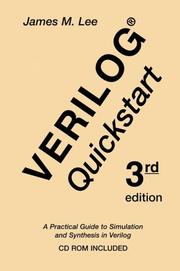
ISBN: 0792376722 9786610206360 1280206365 0306476800 Year: 2002 Publisher: Boston : Kluwer Academic Publishers,
Abstract | Keywords | Export | Availability | Bookmark
 Loading...
Loading...Choose an application
- Reference Manager
- EndNote
- RefWorks (Direct export to RefWorks)
From a review of the Second Edition 'If you are new to the field and want to know what "all this Verilog stuff is about," you've found the golden goose. The text here is straight forward, complete, and example rich -mega-multi-kudos to the author James Lee. Though not as detailed as the Verilog reference guides from Cadence, it likewise doesn't suffer from the excessive abstractness those make you wade through. This is a quick and easy read, and will serve as a desktop reference for as long as Verilog lives. Best testimonial: I'm buying my fourth and fifth copies tonight (I've loaned out/lost two of my others).' Zach Coombes, AMD.
Logische schakelingen. --- Verilog (Computer hardware description language). --- Engineering. --- Computer hardware. --- Computer-aided engineering. --- Electrical engineering. --- Electronic circuits. --- Circuits and Systems. --- Computer Hardware. --- Electrical Engineering. --- Computer-Aided Engineering (CAD, CAE) and Design. --- Verilog (Computer hardware description language) --- Systems engineering. --- Computer engineering. --- Computer aided design. --- Computers. --- CAE --- Engineering --- Electric engineering --- Electron-tube circuits --- Electric circuits --- Electron tubes --- Electronics --- Data processing --- Verilog hardware description language (Computer hardware description language) --- Computer hardware description languages --- Integrated circuits --- Computer simulation
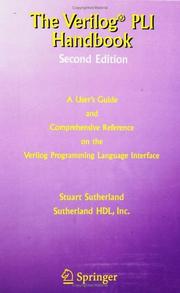
ISBN: 1280201509 9786610201501 0306476657 0792376587 Year: 2002 Publisher: New York, New York ; Boston, Massachusetts : Kluwer Academic Publishers,
Abstract | Keywords | Export | Availability | Bookmark
 Loading...
Loading...Choose an application
- Reference Manager
- EndNote
- RefWorks (Direct export to RefWorks)
by Maq Mannan President and CEO, DSM Technologies Chairman of the IEEE 1364 Verilog Standards Group Past Chairman of Open Verilog International One of the major strengths of the Verilog language is the Programming Language Interface (PLI), which allows users and Verilog application developers to infinitely extend the capabilities of the Verilog language and the Verilog simulator. In fact, the overwhelming success of the Verilog language can be partly attributed to the exi- ence of its PLI. Using the PLI, add-on products, such as graphical waveform displays or pre and post simulation analysis tools, can be easily developed. These products can then be used with any Verilog simulator that supports the Verilog PLI. This ability to create thi- party add-on products for Verilog simulators has created new markets and provided the Verilog user base with multiple sources of software tools. Hardware design engineers can, and should, use the Verilog PLI to customize their Verilog simulation environment. A Company that designs graphics chips, for ex- ple, may wish to see the simulation results of a new design in some custom graphical display. The Verilog PLI makes it possible, and even trivial, to integrate custom so- ware, such as a graphical display program, into a Verilog simulator. The simulation results can then dynamically be displayed in the custom format during simulation. And, if the company uses Verilog simulators from multiple simulator vendors, this integrated graphical display will work with all the simulators.
Verilog (Computer hardware description language) --- Systems engineering. --- Computer hardware. --- Computer aided design. --- Computer engineering. --- Circuits and Systems. --- Computer Hardware. --- Computer-Aided Engineering (CAD, CAE) and Design. --- Electrical Engineering. --- Electronic circuits. --- Computer-aided engineering. --- Electrical engineering. --- Electric engineering --- Engineering --- CAE --- Electron-tube circuits --- Electric circuits --- Electron tubes --- Electronics --- Data processing --- Computer interfaces. --- Verilog hardware description language (Computer hardware description language) --- Computer hardware description languages --- Integrated circuits --- Interfaces, Computer --- Computer input-output equipment --- Interface circuits --- Computer simulation

ISBN: 1558606742 9786611049287 128104928X 0080477151 0585456569 9780585456560 9781558606746 9780080477152 6611049282 Year: 2002 Publisher: San Francisco, CA Morgan Kaufmann
Abstract | Keywords | Export | Availability | Bookmark
 Loading...
Loading...Choose an application
- Reference Manager
- EndNote
- RefWorks (Direct export to RefWorks)
Since the publication of the first edition of The Designer's Guide to VHDL in 1996, digital electronic systems have increased exponentially in their complexity, product lifetimes have dramatically shrunk, and reliability requirements have shot through the roof. As a result more and more designers have turned to VHDL to help them dramatically improve productivity as well as the quality of their designs. VHDL, the IEEE standard hardware description language for describing digital electronic systems, allows engineers to describe the structure and specify the function
VHDL (Computer hardware description language) --- Computer simulation --- VHDL (Langage de description de matériel informatique) --- Simulation par ordinateur --- 681.3.066 --- Electronic digital computers --- -VHDL (Computer hardware description language) --- Very High Speed Integrated Circuits Hardware Description Language (Computer hardware description language) --- VHSIC Hardware Description Language (Computer hardware description language) --- Computer hardware description languages --- Integrated circuits --- Automatic digital computers --- Computers, Electronic digital --- Digital computers, Electronic --- Computers --- Hybrid computers --- Sequential machine theory --- Computerwetenschap--?.066 --- Logische schakelingen --- Ontwerpen --- VHDL (vhsic hardware description language) --- Computer simulation. --- Logische schakelingen. --- Ontwerpen. --- VHDL (vhsic hardware description language). --- VHDL (Computer hardware description language). --- VHDL (Langage de description de matériel informatique)
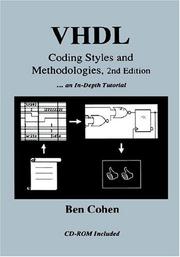
ISBN: 0792384741 9786610201655 1280201657 0306476819 Year: 2002 Publisher: New York : Kluwer Academic Publishers,
Abstract | Keywords | Export | Availability | Bookmark
 Loading...
Loading...Choose an application
- Reference Manager
- EndNote
- RefWorks (Direct export to RefWorks)
VHDL Coding Styles and Methodologies, Edition is a follow up book to the first edition of same book and to VHDL Answers to Frequently Asked Questions, first and second editions. This book was originally written as a teaching tool for a VHDL training course. The author began writing the book because he could not find a practical and easy to read book that gave in depth coverage of both, the language and coding methodologies. This edition provides practical information on reusable software methodologies for the design of bus functional models for testbenches. It also provides guidelines in the use of VHDL for synthesis. All VHDL code described in the book is on a companion CD. The CD also includes the GNU toolsuite with EMACS language sensitive editor (with VHDL, Verilog, and other language templates), and TSHELL tools that emulate a Unix shell. Model Technology graciously included a timed evaluation version of ModelSim, a recognized industry standard VHDL/Verilog compiler and simulator that supports easy viewing of the models under analysis, along with many debug features. In addition, Synplicity included a timed version of Synplify, a very efficient, user friendly and easy to use FPGA synthesis tool. Synplify provides a user both the RTL and gate level views of the synthesized model, and a performance report of the design. Optimization mechanisms are provided in the tool.
VHDL (Computer hardware description language) --- VHDL (Langage de description de matériel informatique) --- Computer aided design. --- Computer engineering. --- Computer hardware. --- Engineering. --- Systems engineering. --- VHDL (Computer hardware description language). --- Electrical Engineering --- Electrical & Computer Engineering --- Engineering & Applied Sciences --- Computer hardware description languages. --- VHDL (Langage de description de matériel informatique) --- EPUB-LIV-FT SPRINGER-B --- Computer-aided engineering. --- Electrical engineering. --- Electronic circuits. --- Circuits and Systems. --- Computer Hardware. --- Electrical Engineering. --- Computer-Aided Engineering (CAD, CAE) and Design. --- CAE --- Engineering --- Electric engineering --- Electron-tube circuits --- Electric circuits --- Electron tubes --- Electronics --- Data processing --- Very High Speed Integrated Circuits Hardware Description Language (Computer hardware description language) --- VHSIC Hardware Description Language (Computer hardware description language) --- Computer hardware description languages --- Integrated circuits --- Computer simulation

ISBN: 1281014028 9786611014025 0080497365 0750655585 9780750655583 9781429483988 1429483989 9780080497365 Year: 2002 Publisher: Oxford [England] Boston, MA Newnes
Abstract | Keywords | Export | Availability | Bookmark
 Loading...
Loading...Choose an application
- Reference Manager
- EndNote
- RefWorks (Direct export to RefWorks)
The authors guide readers quickly and concisely through the complex topics of neural networks, fuzzy logic, mathematical modelling of electrical machines, power systems control and VHDL design. Unlike the academic monographs that have previously been published on each of these subjects, this book combines them and is based round case studies of systems analysis, control strategies, design, simulation and implementation. The result is a guide to applied control systems design that will appeal equally to students and professional design engineers. The book can also be used as a unique VHDL desig
Electric motors, Alternating current. --- Fuzzy systems. --- Motion control devices. --- Power transmission. --- VHDL (Computer hardware description language) --- Very High Speed Integrated Circuits Hardware Description Language (Computer hardware description language) --- VHSIC Hardware Description Language (Computer hardware description language) --- Drives, Mechanical --- Mechanical drives --- Transmission, Power --- Control devices, Motion --- Devices, Motion control --- Systems, Fuzzy --- Computer hardware description languages --- Integrated circuits --- Mechanical engineering --- Power (Mechanics) --- Belts and belting --- Machinery --- Shafting --- Electromechanical devices --- System analysis --- Fuzzy logic --- Computer simulation
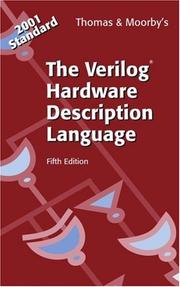
ISBN: 1402070896 1280201517 9786610201518 0306476665 Year: 2002 Publisher: New York : Kluwer Academic Publishers,
Abstract | Keywords | Export | Availability | Bookmark
 Loading...
Loading...Choose an application
- Reference Manager
- EndNote
- RefWorks (Direct export to RefWorks)
This text presents the IEEE 1364-2001 standard of the Verilog language. The examples in this edition have been updated to illustrate the features of the language. A cross referenced guide to these features is provided, thus, designers already familiar with Verilog can quickly learn the features. Newcomers to the language can use it as a guide for reading "old" specifications.; The book should prove to be a useful resource for engineers and students interested in describing, simulating and synthesizing digital systems. It is also ready for use in university courses, having been used for introductory logic design and simulation through advanced VLSI design courses. An appendix with tutorial help and a work-along style is keyed into the introduction for new students. Material supporting a computer-aided design course on the inner working of simulators is also included.; "The Verilog TM Hardware Description Language" includes a CD containing Simucad's Silos TM 2001 Verilog Simulator, examples from the book and lecture slides. The simulator is limited in the size of descriptions it will simulate. A few of the language constructs are not recognized by this version of the simulator.
Verilog (Computer hardware description language) --- Microelectronics. --- Verilog hardware description language (Computer hardware description language) --- Computer hardware description languages --- Engineering. --- Programming languages (Electronic computers). --- Computers. --- Computer-aided engineering. --- Electrical engineering. --- Electronics. --- Electronic circuits. --- Circuits and Systems. --- Programming Languages, Compilers, Interpreters. --- Theory of Computation. --- Computer-Aided Engineering (CAD, CAE) and Design. --- Electronics and Microelectronics, Instrumentation. --- Electrical Engineering. --- Integrated circuits --- Computer simulation --- Engineering --- Technology & Engineering
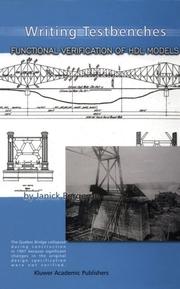
ISBN: 9780792377665 0792377664 9780306476877 9786610201709 1280201703 0306476878 Year: 2002 Publisher: New York : Kluwer Academic Publishers,
Abstract | Keywords | Export | Availability | Bookmark
 Loading...
Loading...Choose an application
- Reference Manager
- EndNote
- RefWorks (Direct export to RefWorks)
CHAPTER 6 Architecting Testbenches 221 Reusable Verification Components 221 Procedural Interface 225 Development Process 226 Verilog Implementation 227 Packaging Bus-Functional Models 228 Utility Packages 231 VHDL Implementation 237 Packaging Bus-Functional Procedures 238 240 Creating a Test Harness 243 Abstracting the Client/Server Protocol Managing Control Signals 246 Multiple Server Instances 247 Utility Packages 249 Autonomous Generation and Monitoring 250 Autonomous Stimulus 250 Random Stimulus 253 Injecting Errors 255 Autonomous Monitoring 255 258 Autonomous Error Detection Input and Output Paths 258 Programmable Testbenches 259 Configuration Files 260 Concurrent Simulations 261 Compile-Time Configuration 262 Verifying Configurable Designs 263 Configurable Testbenches 265 Top Level Generics and Parameters 266 Summary 268 CHAPTER 7 Simulation Management 269 Behavioral Models 269 Behavioral versus Synthesizable Models 270 Example of Behavioral Modeling 271 Characteristics of a Behavioral Model 273 x Writing Testbenches: Functional Verification of HDL Models Modeling Reset 276 Writing Good Behavioral Models 281 Behavioral Models Are Faster 285 The Cost of Behavioral Models 286 The Benefits of Behavioral Models 286 Demonstrating Equivalence 289 Pass or Fail? 289 Managing Simulations 292 294 Configuration Management Verilog Configuration Management 295 VHDL Configuration Management 301 SDF Back-Annotation 305 Output File Management 309 Regression 312 Running Regressions 313 Regression Management 314 Summary 316 APPENDIX A Coding Guidelines 317 Directory Structure 318 VHDL Specific 320 Verilog Specific 320 General Coding Guidelines 321 Comments 321 Layout 323 Syntax 326 Debugging 329 Naming Guidelines 329 Capitalization 330 Identifiers 332 Constants 334 334 HDL Specific Filenames 336 HDL Coding Guidelines 336 337 Structure 337 Layout.
Integrated circuits --- Computer hardware description languages. --- Langages de description de matériel informatique --- Circuits intégrés --- Verification. --- Vérification --- Computer aided design. --- Computer engineering. --- Computer hardware. --- Engineering. --- Integrated circuits - Verification. --- Systems engineering. --- Computer hardware description languages --- Electrical Engineering --- Electrical & Computer Engineering --- Engineering & Applied Sciences --- Verification --- Circuits and Systems. --- Computer Hardware. --- Electrical Engineering. --- Computer-Aided Engineering (CAD, CAE) and Design. --- Electronic circuits. --- Electrical engineering. --- Computer-aided engineering. --- CAE --- Engineering --- Electric engineering --- Electron-tube circuits --- Electric circuits --- Electron tubes --- Electronics --- Data processing --- Hardware verification --- Integrated circuit verification --- Verification of hardware --- Verification of integrated circuits --- Hardware description languages, Computer --- Languages, Computer hardware description --- Electronic digital computers --- Design and construction
| Listing 1 - 10 of 123 | << page >> |
Sort by
|

 Search
Search Feedback
Feedback About UniCat
About UniCat  Help
Help News
News